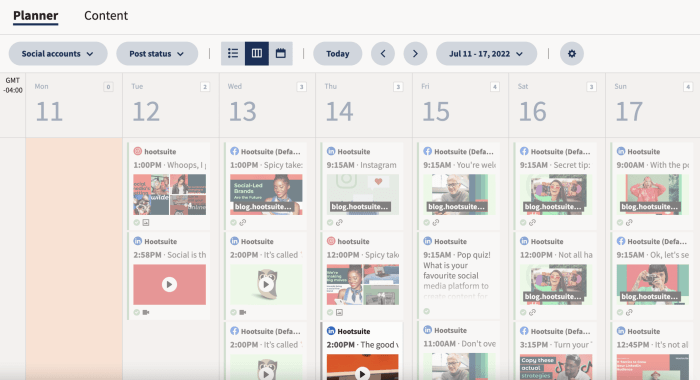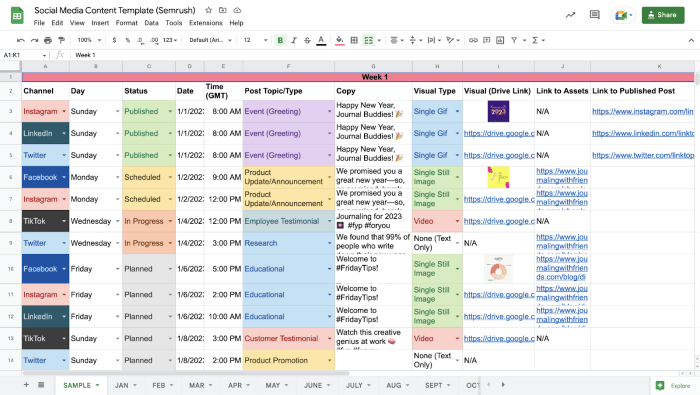Developing a Social Media Posting Schedule is key to boosting your brand’s visibility and engagement. Dive into the world of strategic planning and content creation to elevate your online presence.
Importance of a Social Media Posting Schedule

In today’s digital age, having a well-planned social media posting schedule is crucial for businesses looking to establish a strong online presence and connect with their target audience effectively. Consistency in posting on social media platforms can significantly impact a business’s visibility, engagement, and overall success.
Benefits of Consistency in Posting
- Increased Brand Awareness: By regularly posting content on social media, businesses can keep their brand top-of-mind for their followers and potential customers.
- Improved Engagement: A consistent posting schedule can help businesses maintain a steady flow of interaction with their audience, leading to higher engagement rates.
- Enhanced Reach: Algorithms on social media platforms often favor accounts that post consistently, resulting in increased reach and visibility for businesses.
Examples of a Well-Planned Schedule
For example, a clothing brand that posts daily outfit inspiration on Instagram at the same time each day can build anticipation among its followers and drive higher engagement levels. Similarly, a local restaurant that shares weekly specials on Facebook every Thursday can create a sense of routine for its customers and increase foot traffic to its establishment.
Creating a Social Media Content Calendar
Creating a social media content calendar is essential for maintaining a consistent online presence and engaging with your audience effectively. Here are the steps involved in creating a social media content calendar:
Step 1: Define Your Goals
– Start by identifying your social media marketing goals. Whether it’s increasing brand awareness, driving website traffic, or generating leads, your content calendar should align with these objectives.
Step 2: Know Your Audience
– Understand your target audience’s preferences, demographics, and behaviors to tailor your content calendar to resonate with them effectively.
Step 3: Plan Your Content Themes
– Determine the key themes or topics you want to cover in your social media posts. This will help maintain consistency and relevance in your content calendar.
Step 4: Choose Posting Frequency, Developing a Social Media Posting Schedule
– Decide how often you want to post on each social media platform. Consistency is key, so make sure to establish a posting schedule that you can realistically maintain.
Step 5: Select Scheduling Tools
– Utilize social media management tools like Hootsuite, Buffer, or Sprout Social to schedule and automate your posts across different platforms. These tools can help streamline your content calendar and save you time.
Step 6: Create Content in Advance
– Plan and create your social media content in advance to ensure timely posting and maintain a cohesive brand voice throughout your campaigns.
Step 7: Monitor and Adjust
– Regularly analyze the performance of your social media posts and make adjustments to your content calendar based on audience engagement, feedback, and results.
Tools for Scheduling Posts
When it comes to scheduling posts on social media, there are various tools and software available to help streamline the process and maximize efficiency. Some popular options include:
- Hootsuite
- Buffer
- Sprout Social
- Later
- CoSchedule
Aligning Content with Marketing Strategy: Developing A Social Media Posting Schedule
To ensure that your social media content calendar aligns with your overall marketing strategy, consider the following tips:
- Refer to Your Marketing Plan: Your content calendar should reflect the goals and objectives Artikeld in your marketing plan.
- Consistent Branding: Maintain a consistent brand voice and visual identity across all social media platforms.
- Content Variety: Include a mix of promotional, educational, entertaining, and interactive content to keep your audience engaged.
- Track Performance: Monitor the performance of your social media posts to identify trends and adjust your content strategy accordingly.
Choosing the Right Posting Frequency
Determining the optimal posting frequency for different social media platforms is crucial for maintaining audience engagement and maximizing reach. Posting too much can overwhelm followers and lead to fatigue, while posting too little may cause your content to get lost in the sea of social media updates.
Impact of Posting Too Much or Too Little
- Posting Too Much:
-
Can lead to audience fatigue and unfollows.
-
May decrease the quality of your content as you rush to keep up with the frequency.
-
Could result in lower engagement rates as followers become less responsive.
-
- Posting Too Little:
-
Runs the risk of your content being overlooked or forgotten.
-
May cause a decline in brand visibility and reach.
-
Could lead to a loss of interest from your audience over time.
-
Testing and Adjusting Posting Frequency
- Use Social Media Analytics:
- Track engagement metrics like likes, shares, comments, and click-through rates to gauge the impact of your current posting frequency.
- Experiment with Different Frequencies:
- Try increasing or decreasing your posting frequency gradually to see how it affects audience engagement.
- Solicit Feedback:
- Ask your audience directly through polls or surveys about their preferences regarding posting frequency.
Content Planning and Scheduling

Planning content in advance for a social media posting schedule is crucial for maintaining a consistent online presence and engaging your audience effectively. By creating a content calendar, you can strategize your posts, ensure variety in content types, and align them with your marketing goals.
Balancing Promotional and Non-Promotional Content
Balancing promotional and non-promotional content is key to keeping your audience interested and avoiding coming across as too salesy. While promotional content is important for driving conversions, it’s equally vital to share valuable, educational, entertaining, or inspirational content that resonates with your followers. Striking the right balance will help you build trust and credibility with your audience.
- Share user-generated content or testimonials to showcase customer experiences.
- Create behind-the-scenes glimpses to humanize your brand and connect with your audience on a personal level.
- Curate industry news, trends, or relevant articles to position your brand as a thought leader.
- Run contests, polls, or interactive posts to boost engagement and foster a sense of community.
Repurposing Content Across Different Platforms
Repurposing content across different platforms allows you to maximize your efforts and reach a broader audience without constantly creating new content from scratch. By adapting your content to suit each platform’s unique requirements and audience preferences, you can extend its lifespan and effectiveness.
For example, you can repurpose a blog post into a series of social media posts, an infographic, a video, or a podcast episode. Each format caters to different consumption habits and preferences, ensuring wider reach and engagement.
- Transform a webinar recording into short video clips for Instagram Stories or TikTok.
- Turn a successful tweet into a longer-form LinkedIn post or Facebook status update.
- Repurpose a product demo video into a how-to guide for your website or YouTube channel.
- Convert a customer testimonial into an eye-catching graphic for Pinterest or Twitter.












